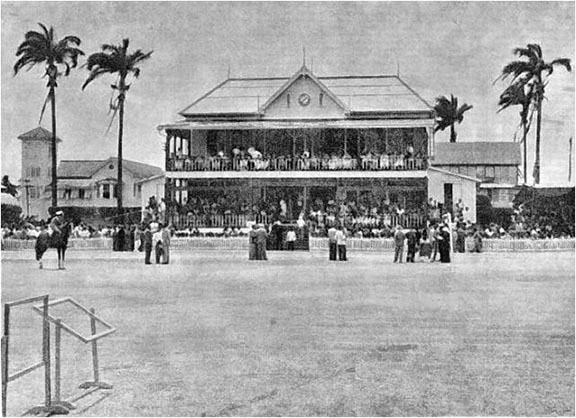By Peter Mason
This is an edited version of an article in the latest issue of Nightwatchman, a quarterly cricket magazine published by Wisden https:// www.thenightwatchman.net
If there are few more poignant images in sport than a once-great venue crumbling into dust, then the sight of the Bourda cricket ground must be one of the saddest to behold.
Bourda was – and just about still is – one of the most wonderful cricketing stages. The oldest major ground in the Caribbean, opened in 1885 on eight acres of former sugar-cane fields once owned by the Frenchman Joseph Bourda, it was a picturesque, idiosyncratic and sometimes volatile tropical home to West Indies from 1930 to 2005.
But when the World Cup came to town in 2007, a new stadium was built in Providence, and since then the clock has been ticking for the old ground. Time is about to run out.
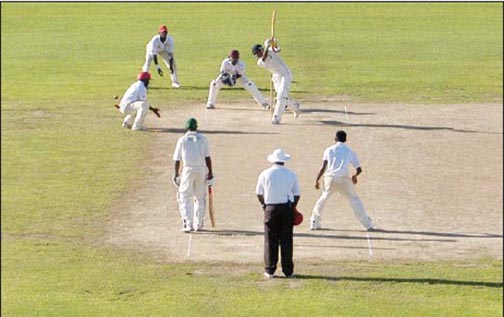
With the advent of Providence went Bourda’s inalienable right to stage the biggest matches in Guyana, plus any hope of a stable future for its mainly wooden buildings. Already the Clive Lloyd stand next to the pavilion has been demolished, rotten beyond redemption, and the Lance Gibbs enclosure – a creaking tangle of splintered planks and nails – looks next to go.
The large Rohan Kanhai stand is showing signs of wear and tear, while around the rest
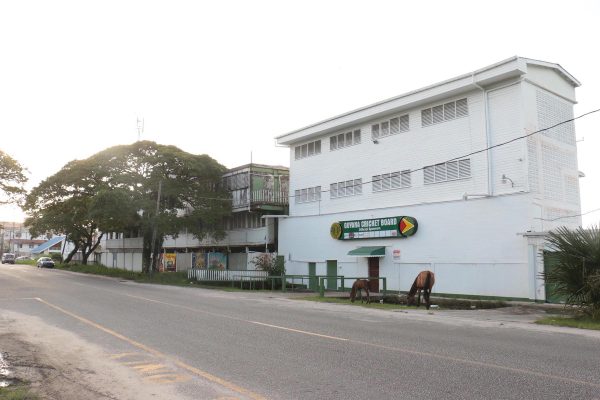
of the ground the open wooden bleachers, once alive with music and noise, are collapsing and unsafe, overgrown with creepers and vines. The back of the pavilion looks distinctly unsteady, and tellingly, there are now more adverts on the outside of the ground for the benefit of passing traffic than there are inside for spectators.
In days gone by, with the ground filled to capacity, this was a vibrant place to watch cricket, populated with knowledgeable crowds whose passion sometimes spilled over into bottle-throwing and pitch invasions. Now there is just sadness and decay. Bourda still hosts local finals and big club matches, and it remains the home of Georgetown Cricket Club, which was founded way back in 1858. But gone are the Test and ODI games that were once its lifeblood. No safety-conscious fan would dare set foot in many of its parts these days, let alone attempt to watch a match from its decrepit, unstable environs.
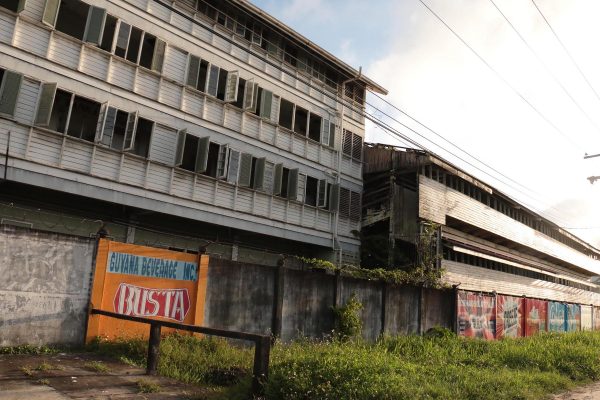
Perhaps the only thing preventing the ground from being a complete write-off is the magnificent pavilion, which, though showing its age, keeps its chin up amid the surrounding degeneration. Dating in parts to 1910, here is one of the most wonderful buildings in cricket: a three-tiered jumble of wooden pillars, posts, louvres and shutters, breeze-ridden in the heat and full of memories.
Above the pavilion’s colonial-era floorboards and across its green and white walls there are photos, paintings and memorabilia which speak of a history that ranks with any ground in the world.
The archaic, wooden changing-rooms, forbidding entry “without permission of captain”, are still equipped with a self-standing bath tub. In the members’ area there’s an old snooker room and card tables.
Local trophies sit on any available space around the well-appointed bar, and
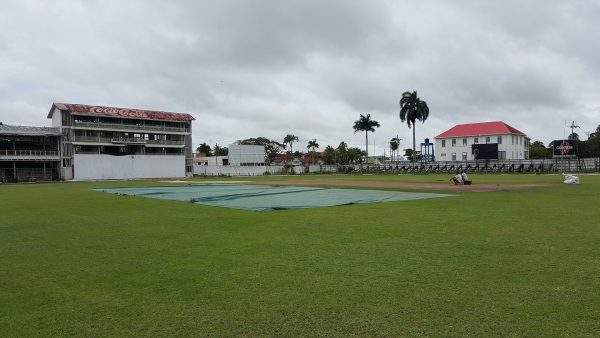
everywhere there are honours boards telling of international deeds at the ground. From these we learn that Bourda’s first Test was against England in February 1930, only the third home match to be contested by West Indies and the first they won, thanks to a century in each innings from George Headley and 209 from Clifford Roach.
Thirty Tests have been staged at Bourda – behind only Bridgetown, Sabina Park and Port of Spain in the Caribbean. West Indies’ one-day record at the ground, from 1988 to 2006, was impressive (won six, lost three, tied two) but they fared less well in Tests (won seven, lost six, drew 17) – the large number of draws an indication of the wet conditions that have bedevilled a ground that is below sea level and liable to flooding. The Test against England in 1990 was so dogged by rain that it was abandoned without a ball being bowled.
Despite the general wetness, Bourda has historically been a decent wicket – rather slow and inclined towards the batsman, with a quick outfield. Another board in the pavilion reveals that Test centuries have come at an average of two per game – 61 in all – with Garfield Sobers and Chanderpaul having scored four apiece. Richie Richardson registered three and Jacques Kallis notched up the most recent, in the last Test played there in March 2005. The highest Test score is by New Zealand’s Glenn Turner, who posted 259 in 1972.
Because of the pitch’s benign reputation, Wes Hall reckoned that his 6 for 90 at Bourda against England in 1960 was his best Test performance, even though he had better returns elsewhere. The best bowling figures are by the less well known Australian Ian Johnson, who took 7 for 44 in 1955. But the greats are up there too, including Imran Khan, Lance Gibbs, Joel Garner and the father of West Indies cricket, Learie Constantine, who took 5 for 87 to wrap up victory in the 1930 Test.
The boards have space for further entries but for the present they are frozen in time, like so many of the photographs that line the pavilion walls. A washed-out colour image of a resplendent Bourda hosting a Test against New Zealand in 1996 gives no hint of the decline to come; a portrait of the Guyanese cricketer Claude Wight, who made his debut for West Indies in 1928, has faded so much that it has become a blank piece of paper in a frame.
It feels as if the ground is about to fade away too. But it would be wrong to portray Bourda entirely as a dead zone. There’s still plenty of life here on any day you care to visit: aerobics classes and hockey sessions take place where once there was the Clive Lloyd stand; there are nets out in the middle and club matches on the weekend; and members drop in for a midweek beer while they watch the IPL on television. As long as such activity continues, there is hope. Yet as each day passes the rapacious local climate eats away at Bourda’s fabric and the prospects of saving the last vestiges of this great ground recede.
Six miles south on the road to the main airport, the 15,000-capacity Providence stadium is actually a fine place to watch cricket. Its stands, built by an Indian firm, have a distinctly Caribbean feel and the state-of-the-art facilities have been created respectfully with regard to local surroundings. Cricket in Guyana has experienced unprecedented success since all the important matches moved here from Bourda, with a fourth regional four-day competition claimed in early 2018. So it can hardly be argued that the switch has been harmful to the game.
It has, however, done nothing for the spirit of cricket. Providence is a stadium, not a ground.
Most Guyanese need to make a concerted effort to get there by bus or taxi; no one, anymore, wanders out from their front porch to catch a couple of hours around lunchtime or at the end of the working day, as they did at Bourda. Regional four-day games are often watched by only a handful of people, and the stands have rarely been well populated even for the 19 ODIs and two Tests that the stadium has staged. Providence has no vibrancy and no soul, and the game now feels more distant from the people.
Former England captain Mike Atherton, who is married to a Guyanese and scored 144 in his first game at Bourda in 1994, regrets that loss of character. “I loved playing there – it was a really atmospheric ground, albeit a very slow pitch,” he says. “In general, I’m sad that grounds at the heart of the community like Bourda and the Rec in Antigua have been replaced by sterile out-of-town stadia.”
The World Cup in the West Indies changed the face of many cricketing venues, upgrading some and squeezing the life out of others. What happened to Bourda also happened to Antigua’s much-loved Recreation Ground, a place with charisma that was sidelined by the antiseptic, out-of-town Viv Richards Stadium. And around the world the picture is much the same, not just in cricket but in sport as a whole. Stadia that were once the heart of local communities now stand on the edge of conurbations in soulless industrial parks, accessible only by car.
In that sense Bourda’s travails are a manifestation of a more general trend. And that’s why its survival could be an important victory. Bringing Bourda back from the brink would recognise that cricket grounds are as much about a sense of place as about facilities.
Bourda can be rescued if there is a collective will to do so. Certainly it cannot sustain many more years of neglect before it finally falls into a heap. But it is salvageable. The pavilion and the Kanhai stand both need re-upholstering, and modest new structures can be built where old ones have fallen away. The outfield drainage needs to be addressed, and floodlights would be a boon. The scope of such improvements is not prohibitively expensive.
With offshore oil discoveries raising the prospect of new revenues coming into the country, it would be nice to think that some cash could be made available for an overhaul of what has been, and should remain, a national monument as significant as any building in Guyana. Then Bourda could be afforded the luxury of hosting internationals again, and cricket could celebrate the return of one of its most glittering assets.
